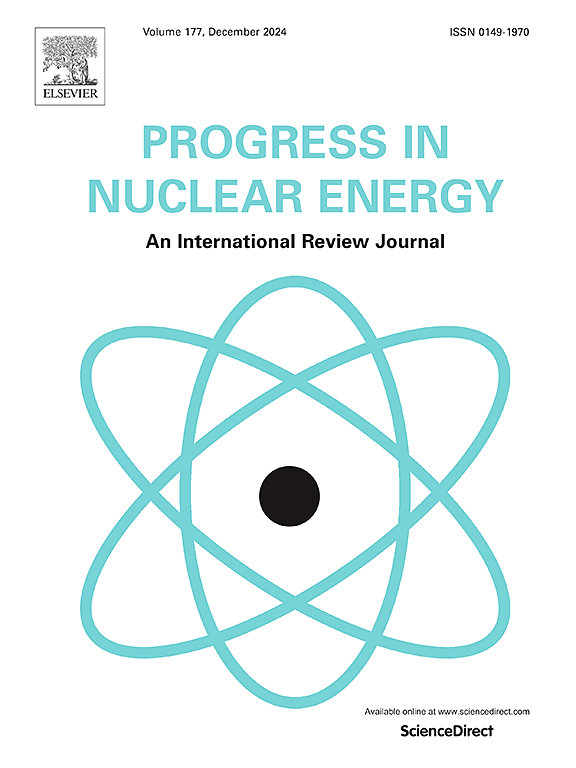SMR无溶硼运行中考虑控制棒损耗的两步码系统截面模型的建立
IF 3.2
3区 工程技术
Q1 NUCLEAR SCIENCE & TECHNOLOGY
引用次数: 0
摘要
本文展示了一个先进的横截面模型,包括小型模块化反应器(SMRs)的可溶无硼运行控制棒损耗,特别是利用STREAM/RAST-K两步代码系统。随着对smr的需求不断增长以及向无硼操作的转变,控制棒对于控制过度反应性至关重要。然而,控制棒的插入会改变中子谱,并消耗燃料和控制棒材料,因此需要更精确的建模方法。传统的两步代码系统截面模型无法充分解决燃料耗尽过程中控制棒插入的影响。在先进的截面模型中,可以跟踪燃料和控制棒耗尽引起的微观截面和数密度变化。此外,该方法结合了使用历史指数变量的有棒和无棒燃料消耗的横截面集。利用smr的多周期耗损计算,针对整个核心传输代码(STREAM3D)验证了新方法,显示出控制棒价值和功率分布预测的准确性。虽然由于误差抵消,反应性预测显示出类似的精度,但总体方法提高了反应堆物理计算的精度。本文章由计算机程序翻译,如有差异,请以英文原文为准。
Development of cross-section model of two-step code system considering control rod depletion for soluble boron free operation of SMR
This paper demonstrates an advanced cross-section model including a control rod depletion for the soluble boron-free operation of small modular reactors (SMRs), specifically utilizing the STREAM/RAST-K two-step code system. With the growing demand for SMRs and the shift toward boron-free operations, control rods are essential for controlling excess reactivity. However, the insertion of control rods changes the neutron spectrum and depletes both the fuel and control rod material, necessitating a more accurate modeling approach. It is impossible to adequately address the effects of control rod insertion during fuel depletion using traditional cross-section model from two-step code system. In advanced cross-section model, the microscopic cross-section and number density changes caused by fuel and control rod depletion is possible to track. Also, this approach combines cross-section set from both rodded and unrodded fuel depletion using a history index variable. The new method is verified against whole core transport code (STREAM3D) using multi-cycle depletion calculations of SMRs, showing improved accuracy in control rod worth and power distribution predictions. Although reactivity predictions showed similar accuracy due to error cancellation, the overall method enhances precision in reactor physics calculations.
求助全文
通过发布文献求助,成功后即可免费获取论文全文。
去求助
来源期刊

Progress in Nuclear Energy
工程技术-核科学技术
CiteScore
5.30
自引率
14.80%
发文量
331
审稿时长
3.5 months
期刊介绍:
Progress in Nuclear Energy is an international review journal covering all aspects of nuclear science and engineering. In keeping with the maturity of nuclear power, articles on safety, siting and environmental problems are encouraged, as are those associated with economics and fuel management. However, basic physics and engineering will remain an important aspect of the editorial policy. Articles published are either of a review nature or present new material in more depth. They are aimed at researchers and technically-oriented managers working in the nuclear energy field.
Please note the following:
1) PNE seeks high quality research papers which are medium to long in length. Short research papers should be submitted to the journal Annals in Nuclear Energy.
2) PNE reserves the right to reject papers which are based solely on routine application of computer codes used to produce reactor designs or explain existing reactor phenomena. Such papers, although worthy, are best left as laboratory reports whereas Progress in Nuclear Energy seeks papers of originality, which are archival in nature, in the fields of mathematical and experimental nuclear technology, including fission, fusion (blanket physics, radiation damage), safety, materials aspects, economics, etc.
3) Review papers, which may occasionally be invited, are particularly sought by the journal in these fields.
 求助内容:
求助内容: 应助结果提醒方式:
应助结果提醒方式:


